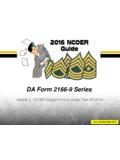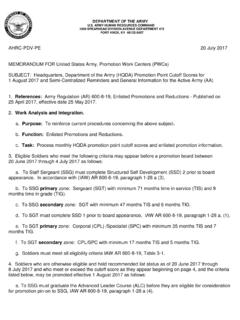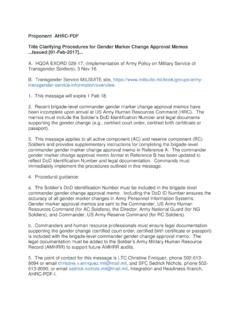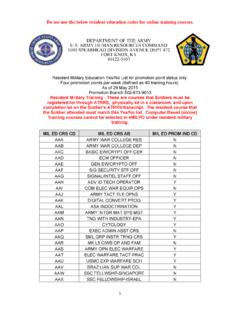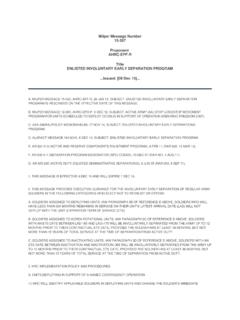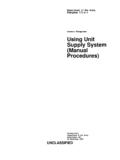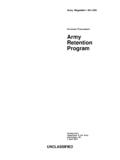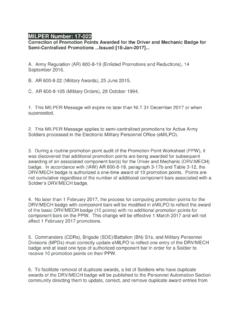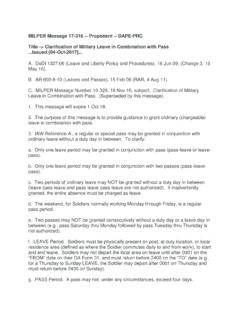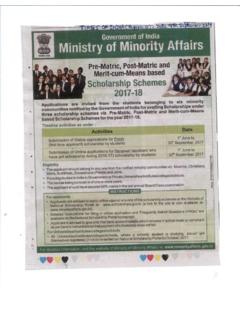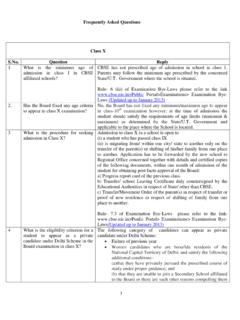Transcription of NCOER FAQs as of 8 July 2015 - NCOsupport.com
1 1 NCOER faqs as of 8 july 2015 (NOTE: Press and hold the CTRL key while pressing f to bring up a box to do a keyword search of this document.) 1. When will the new NCOER be available? A: Due to the recently approved changes, the scheduled implementation is 1 January 2016. 2. What is the reason for the delay? A: During a review of the new NCOER , the Sergeant Major of the Army and his Senior Enlisted Council expressed concerns about the effects of the 49% MOST QUALIFIED control box assessment on future NCO promotion rates. In order to identify the absolute best talent within the NCO Corps, the SMA and his Senior Enlisted Council recommended to the CSA and SECARMY and they approved a senior rater profile limited to 24%. This change will slightly postpone implementation (1 January 2016) to allow HRC to revise IT systems, publications, forms, and Army-wide training materials. 3. Will I still be competitive if I receive a HIGHLY QUALIFIED NCOER ?
2 A: Yes. Because the HIGHLY QUALIFIED box will be the norm, NCOs will remain competitive for promotion with HIGHLY QUALIFIED NCOERs given they complete their required professional military education. 4. With a senior rater profile limited to 24%, when will a senior rater be able to render a second MOST QUALIFIED selection if they already utilized their Silver bullet? A third MOST QUALIFIED? A fourth MOST QUALIFIED? A: Because the senior rater profile is limited to 24%, a senior rater can render a MOST QUALIFIED assessment for a particular grade (E-6 through E-9) as follows: Any one of the first four reports The second MOST QUALIFIED assessment no earlier than the ninth report (2 / 9 = ) The third MOST QUALIFIED assessment no earlier than the thirteenth report (3 / 13 = ) The fourth MOST QUALIFIED assessment no earlier than the seventeenth report (4 / 17 = ) 5. Does the senior rater profile have to be and less or will be allowed?
3 A: The senior rater profile cannot be greater than 24%, so would exceed the profile limitation and result in a misfire. 6. In regard to the Silver bullet exception, does that still apply with the new senior rater profile limited to 24%? A: Yes. A senior rater will still be able to render a MOST QUALIFIED selection for any one of the first four reports rendered for a particular grade (E-6 through E-9). In the event a senior rater does not render a MOST QUALIFIED selection for any of the first four reports, then the Silver bullet exception would not be needed for the fifth report or later. 2 7. What is pooling? A: Pooling, or elevating the rating chain beyond the senior rater s ability to have adequate knowledge of each Soldier s performance and potential, in order to provide an elevated assessment protection for a specific group, runs counter to the intent of the Evaluation Reporting System (ERS). Rating schemes based on pooling erode Soldiers confidence in the fairness of the ERS and in their leaders.
4 Senior raters must evaluate and identify their best Soldiers based on performance and potential, regardless of the particular position they occupy. 8. With the senior rater profile limited to 24%, won t this encourage pooling to ensure the best talent is identified? A: Both, the Chief of Staff of the Army and Sergeant Major of the Army, are adamant that leaders at every level establish and approve rating chains in accordance with AR 623-3. By doing so, commanders and key leaders ensure a fair and equitable system across the Army. Pooling is in violation of AR 623-3 and it erodes Soldiers confidence in the system and in their leaders. Not only can it affect good order and discipline within the unit, there is the potential for increased inspector general (IG) complaints and/or legal inquiries which may affect mission readiness. 9. Is there an update to the supplementary review requirement? A: Yes. In most instances, the senior rater will conduct the final rating chain review of the NCOER .
5 Some cases exist when a supplementary review may be required. These include: When the senior rater is in the rank of 2LT-1LT, WO1-CW2, or SFC-1SG/MSG. The supplementary reviewer will be senior to the senior rater and a uniformed Army-designated rating official in the rank of CSM/SGM, CW3-CW5, or CPT and above. The second instance in which a supplementary reviewer is required is when no uniformed Army-designated rating official in the rank of CSM/SGM, CW3-CW5, or CPT and above exists in the rating chain for the rated NCO. The third instance is for Relief for Cause evaluations, when the senior rater or someone outside the rating chain directs the relief. 10. When you have a CW3 as the rater and a 1LT as the senior rater, do you require a supplementary reviewer? A: No. Because there is a uniformed Army-designated rating official in the rank of CW3 in the rating chain, a supplementary reviewer is not required. 11. A supplementary review is not applicable if the rater of a SSG is an Army MSG and the senior rater is an Air Force CPT.
6 True or False? A: False. A supplementary reviewer is required when no uniformed Army-designated rating official in the rank of CSM/SGM, CW3-CW5, or CPT and above exists in the rating chain for the rated NCO. 12. If a SSG(P) was serving in an authorized SFC position, which rank would a rendered NCOER count towards when calculating the senior rater s profile? A: SFC. 13. What is the minimum calendar day requirement for senior raters of USAR TPU, DIMA, and drilling IRR Soldiers and ARNG Soldiers? A: 90 days. 3 14. Can a British captain serve as a rater for NCOs of all ranks? A: Yes. Service members of allied forces may serve as a rater only for all NCOs. 15. Can a senior rater s rater serve as both rater and senior rater for an NCO, if both rating officials (rater and senior rater) get relieved? A: Yes. On a case-by-case basis and as an exception to policy, HQDA can approve the senior rater s rater to serve as both rater and senior rater on the rated NCO s NCOER .
7 In order for this individual to evaluate the rated NCO as the senior rater, he or she must be a member of the Armed Forces or employee of DOD, be of the appropriate rank or grade to senior rate, and have adequate knowledge of the rated NCO s performance and potential to qualify them to render an evaluation in place of the removed senior rater. Minimum senior rater time qualifications for this individual are not required. 16. What is the highest percentage a senior rater can maintain for MOST QUALIFIED ratings per grade? A: 24%. 17. Where are ARNG NCOERs on the DA Form 2166-8 going to be processed after 1 January 2016? A: The State EPM. 18. Are raters allowed to assess performance and potential? A: No. Raters may assess performance only. 19. How many successive and broadening assignments must the senior rater provide? A: 2 Successive assignments, 1 Broadening assignment. 20. What format must enclosures to the DA Form 2166-9 series be in?
8 A: Enclosures must be in .pdf, .jpg, or .tiff format. 21. Can a rating official submit an addendum for an NCOER while the evaluation is being processed at HQDA? A: No. An addendum may be submitted for an NCOER previously processed that has posted to the rated NCO s AMHRR. 22. What is the NLT date a commander s or commandant s inquiry can be requested once signed by the rated NCO? A: A request for a commander s or commandant s inquiry will occur no later than 60 days after the signature date of the rated NCO (or senior rater if the rated NCO s signature is omitted). 23. What forms comprise the DA Form 2166-9 Series? A: DA Form 2166-9 series is comprised of the following forms: DA Form 2166-9-1A (Support Form) DA Form 2166-9-1 (Direct-level) DA Form 2166-9-2 (Organizational-level) DA Form 2166-9-3 (Strategic-level) 4 24. What form is used to assess SSG-1SG/MSG? A: DA Form 2166-9-2 (Organizational-level). 25. If the rated NCO s or rating official s DOD ID Number is not available, can the SSN be used?
9 A: Yes. 26. What is the rated NCO s signature verifying? A: The rated NCO s signature will verify the accuracy of administrative data in Part I, the rating officials and counseling dates in Part II, the duty description in Part III, and the APFT and HT/WT entries in Part IV. 27. Which Army attribute discusses the adherence to Army Values? A: Character. 28. Performs above the required Army standards and organizational goals of leader competencies and attributes describes which rater overall performance assessment? A: EXCEEDED STANDARD. 29. Demonstrates strong potential for promotion with peers describes which senior rater overall potential assessment? A: HIGHLY QUALIFIED. 30. What is the primary function of the evaluation reporting system? A: The primary function of the evaluation reporting system is to provide key information to HQDA for use in making critical personnel management decisions ( , promotions / key assignments).
10 31. What are centralized promotions based on? A: Centralized promotions are based on current and future force structure requirements. 32. What is the primary role of a rater? A: The rater s role is to assess the rated NCO s day-to-day performance and conduct counseling. 33. What is the primary role of a senior rater? A: The senior rater s role is to assess the rated NCO s potential and provide guidance and mentorship. 34. What is the primary role of a supplementary reviewer? A: The supplementary reviewer s role is to monitor evaluation practices and provide assistance and advice needed to rating officials (as required) on matters pertaining to Army evaluations. The supplementary reviewer will be identified on the published rating scheme at the beginning of the evaluation period by the commander establishing the rating chain. 5 35. Who establishes and approves rating chains? A: The commanders, commandants, and organization leaders will establish rating chains and publish rating schemes within their units or organizations in accordance with locally-developed procedures and regulations.
